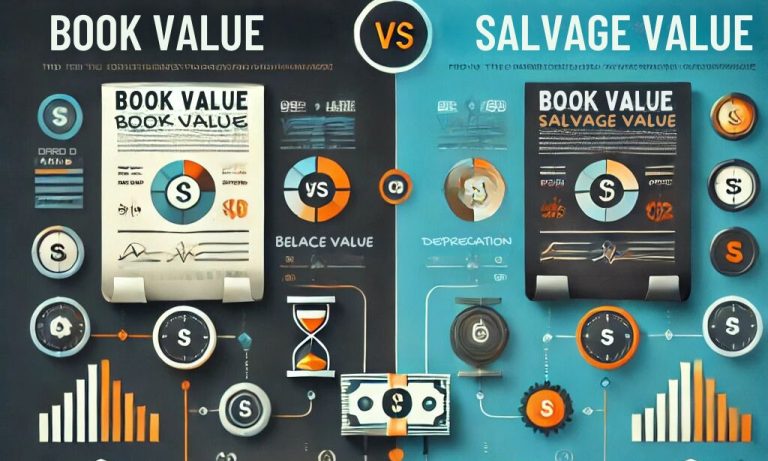The difference between book value and salvage value lies in their definitions, purpose, and usage in accounting and financial analysis. Book value is the proper accounting value for an asset in accounting records after depreciation, whereas salvage value is the estimated residual value at the end of an asset’s useful life. Understanding these terms will be important for proper financial reporting, correct valuation of assets, and planning for the replacement or disposal of assets.
What is Book Value?
Book value is the value of an asset recorded in a company’s financial statements. It represents the asset’s original purchase price minus accumulated depreciation, amortization, or impairment costs. Book value reflects the asset’s net worth from an accounting perspective.
Key Features of Book Value
The features of book value highlight its role in determining a company’s financial health by reflecting its net asset value, calculated by subtracting liabilities from assets.
- Accounting Perspective: Book value is calculated by subtracting accumulated depreciation from the original cost of an asset. Depreciation reflects the asset’s loss in value over time due to usage, wear, or obsolescence.
- Depreciation Adjustments: As assets are used, their book value decreases due to periodic depreciation. Depreciation is recorded as an expense and directly reduces the asset’s book value on the balance sheet.
- Represents Net Worth: Book value represents the remaining value of an asset after depreciation and adjustments. It reflects the asset’s net worth for financial reporting, but it doesn’t always align with the market value, which can fluctuate due to external factors.
- Static Value (Changes with Adjustments): Book value is generally static, changing only when adjustments like depreciation or impairment are recorded. Impairment may occur if the asset’s market value falls below its book value.
The formula for Book Value
Example: An asset purchased for ₹1,00,000 with accumulated depreciation of ₹60,000 has a book value of: ₹1,00,000−₹60,000=₹40,000
What is Salvage Value?
Salvage value, also known as residual value, is the estimated amount an asset is expected to fetch at the end of its useful life when it is disposed of or sold. It helps determine the depreciation expense for an asset over its lifespan.
Key Features of Salvage Value
It’s an important factor in accounting and finance, as it helps in determining depreciation and assessing the asset’s remaining worth. Here are the key features of salvage value:
- Estimated Value: Salvage value is determined based on the asset’s market conditions, usage, and wear and tear. It reflects the expected amount that can be recovered from selling or disposing of the asset at the end of its useful life.
- Depreciation Basis: The salvage value plays a crucial role in calculating depreciation expenses. It is subtracted from the asset’s purchase price to determine the total depreciable amount. The salvage value essentially reduces the overall amount being depreciated, thus affecting the financial statements.
- Final Asset Value: The salvage value represents the remaining worth of the asset after it has been used for its intended purpose. This final value is what an owner expects to recover when the asset is disposed of or sold after reaching the end of its useful life.
- Market Dependent: The salvage value can fluctuate depending on various market factors, such as demand, supply, and the condition of the asset. As market conditions change, so does the potential value of the asset when it is sold or salvaged.
The formula for Salvage Value
Example: A machine purchased for ₹5,00,000 is expected to have a salvage value of ₹50,000 after 10 years.
Difference Between Book Value & Salvage Value
The book value vs salvage value comparison highlights their unique roles in accounting and financial analysis. Below are five key differences:
Definition
- Book Value: The book value of an asset refers to its current worth in the accounting records, which is calculated by subtracting accumulated depreciation from the asset’s original purchase price. It represents the remaining value of the asset as it is used over time in business operations.
- Salvage Value: Salvage value is the estimated residual value of an asset at the end of its useful life. This value is often based on an estimation of how much the asset can be sold for once it is no longer usable in its original capacity.
Calculation Basis
- Book Value: Book value is determined by subtracting the accumulated depreciation from the asset’s initial cost. The depreciation reflects how much of the asset’s value has been used up over time.
- Salvage Value: Salvage value is usually based on the estimated market value of the asset, which considers its current condition, demand, and potential resale value. This estimate can vary depending on market conditions and the asset’s physical state at the time of disposal.
Time Frame
- Book Value: Book value represents the asset’s worth during its useful life. As the asset is used, its book value decreases over time due to depreciation.
- Salvage Value: Salvage value, however, comes into play at the end of the asset’s useful life, representing the amount the asset is expected to fetch after it is no longer in service. It does not affect the asset’s value during its usage but is critical when the asset is disposed of or sold.
Purpose
- Book Value: Book value is primarily used for financial reporting and balance sheet purposes. It provides a clear picture of an asset’s worth according to accounting principles and helps businesses assess the remaining value of their assets.
- Salvage Value: It plays a crucial role in depreciation calculations and disposal planning. It allows businesses to estimate the potential value they might recover when the asset is no longer in use.
Nature
- Book Value: The book value of an asset is determined by accounting standards and principles, which govern how depreciation is applied over time. It is a more formal and regulated calculation.
- Salvage Value: Salvage value, in contrast, is typically based on market estimates and assumptions, and it can vary depending on factors like the asset’s condition, technological obsolescence, and market demand at the time of disposal.
| Aspect | Book Value | Salvage Value |
| Definition | The current worth of an asset in accounting records after depreciation. | Estimated residual value at the end of its useful life. |
| Calculation Basis | The original purchase price minus accumulated depreciation. | Estimated market value based on condition and demand. |
| Time Frame | Reflects the asset’s value during its useful life. | Represents the value after the asset’s useful life ends. |
| Purpose | Used for financial reporting and balance sheets. | Used for depreciation and disposal planning. |
| Nature | Determined by accounting principles. | Determined by market estimates and assumptions. |
Conclusion
Book value versus salvage value is the point of difference between asset valuation in accounting and finance. While book value reflects the current worth of an asset on the books, salvage value calculates how much it would be worth at the end of its useful life. Both are thus critical to financial reporting, calculating a correct amount of depreciation, and even in the plans of disposal. Therefore, mastering these concepts is vital in asset management and planning for financial well-being in business.
Book Value vs Salvage Value FAQs
What is the main difference between book value and salvage value?
Book value is the asset’s current worth in accounting records, while salvage value is its estimated residual value at the end of its life.
How is book value calculated?
Book value is calculated by subtracting accumulated depreciation from the asset’s original purchase price.
Why is salvage value important in depreciation?
Salvage value helps determine the total depreciable amount of an asset over its useful life.
Can book value and salvage value be the same?
Rarely, but it can happen if an asset’s depreciation aligns with its estimated salvage value.
What happens if salvage value is overestimated?
Overestimation can lead to understated depreciation expenses, affecting financial accuracy.


